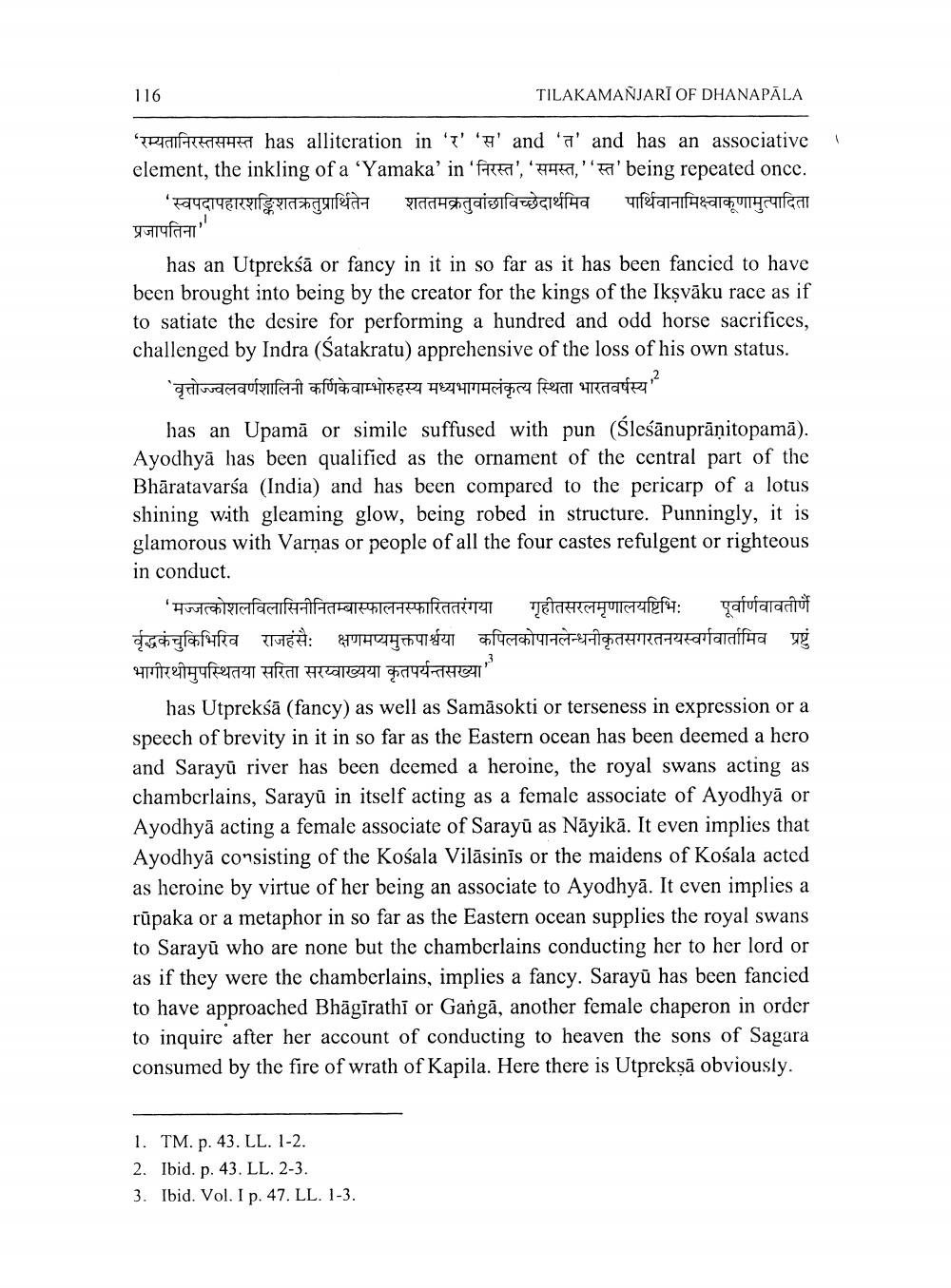________________
116
TILAKAMANJARĪ OF DHANAPĀLA
!
pa 4 4* has alliteration in 'T' '' and 'a' and has an associative element, the inkling of a 'Yamaka' in 'Fr',7469,' ' being repeated once.
'स्वपदापहारशङ्किशतक्रतुप्रार्थितेन शततमक्रतुवांछाविच्छेदार्थमिव पार्थिवानामिक्ष्वाकुणामुत्पादिता प्रजापतिना"
has an Utprekśā or fancy in it in so far as it has been fancied to have been brought into being by the creator for the kings of the Ikşvāku race as if to satiate the desire for performing a hundred and odd horse sacrifices, challenged by Indra (Satakratu) apprehensive of the loss of his own status.
'वृत्तोज्ज्वलवर्णशालिनी कर्णिकेवाम्भोरुहस्य मध्यभागमलंकृत्य स्थिता भारतवर्षस्य"
has an Upamā or simile suffused with pun (Sleśānuprānitopamā). Ayodhyā has been qualified as the ornament of the central part of the Bhāratavarśa (India) and has been compared to the pericarp of a lotus shining with gleaming glow, being robed in structure. Punningly, it is glamorous with Varņas or people of all the four castes refulgent or righteous in conduct.
'मज्जत्कोशलविलासिनीनितम्बास्फालनस्फारिततरंगया गृहीतसरलमृणालयष्टिभिः पूर्वार्णवावतीर्णे वृद्धकंचुकिभिरिव राजहंसैः क्षणमप्यमुक्तपार्श्वया कपिलकोपानलेन्धनीकृतसगरतनयस्वर्गवार्तामिव प्रष्टुं भागीरथीमुपस्थितया सरिता सरय्वाख्यया कृतपर्यन्तसख्या''
has Utprekśā (fancy) as well as Samāsokti or terseness in expression or a speech of brevity in it in so far as the Eastern ocean has been deemed a hero and Sarayū river has been deemed a heroine, the royal swans acting as chamberlains, Sarayū in itself acting as a female associate of Ayodhyā or Ayodhyā acting a female associate of Sarayū as Nāyikā. It even implies that Ayodhyā consisting of the Košala Vilāsinīs or the maidens of Kosala acted as heroine by virtue of her being an associate to Ayodhyā. It even implies a rūpaka or a metaphor in so far as the Eastern ocean supplies the royal swans to Sarayū who are none but the chamberlains conducting her to her lord or as if they were the chamberlains, implies a fancy. Sarayū has been fancied to have approached Bhāgirathi or Gangā, another female chaperon in order to inquire after her account of conducting to heaven the sons of Sagara consumed by the fire of wrath of Kapila. Here there is Utpreksā obviously.
1. TM. p. 43. LL. 1-2. 2. Ibid. p. 43. LL. 2-3. 3. Ibid. Vol. I p. 47. LL. 1-3.




